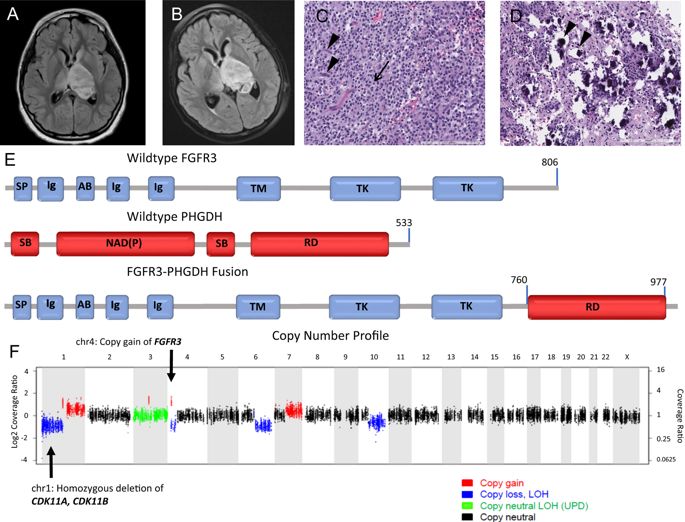当前位置:
X-MOL 学术
›
npj Precis. Oncol.
›
论文详情
Our official English website, www.x-mol.net, welcomes your
feedback! (Note: you will need to create a separate account there.)
Identification and targeting of an FGFR fusion in a pediatric thalamic "central oligodendroglioma".
npj Precision Oncology ( IF 6.8 ) Pub Date : 2017-01-01 , DOI: 10.1038/s41698-017-0036-8 Joseph R. Linzey , Bernard Marini , Kathryn McFadden , Adonis Lorenzana , Rajen Mody , Patricia L. Robertson , Carl Koschmann
npj Precision Oncology ( IF 6.8 ) Pub Date : 2017-01-01 , DOI: 10.1038/s41698-017-0036-8 Joseph R. Linzey , Bernard Marini , Kathryn McFadden , Adonis Lorenzana , Rajen Mody , Patricia L. Robertson , Carl Koschmann

|
Approximately 1-5% of pediatric intracranial tumors originate in the thalamus. While great strides have been made to identify consistent molecular markers in adult oligodendrogliomas, such as the 1p/19q co-deletion, it is widely recognized that pediatric oligodendrogliomas have a vastly different molecular make-up. While pediatric thalamic or "central oligodendrogliomas" are histologically similar to peripheral pediatric oligodendrogliomas, they are behaviorally distinct and likely represent a cohesive, but entirely different entity. We describe a case of a 10-year-old girl who was diagnosed with an anaplastic glioma with features consistent with the aggressive entity often diagnosed as central or thalamic oligodendroglioma. We performed whole-exome (paired tumor and germline DNA) and transcriptome (tumor RNA) sequencing, which demonstrated an FGFR3-PHGDH fusion. We describe this fusion and our rationale for pursuing personalized, targeted therapy for the patient's tumor that may potentially play a role in the treatment of similar cases.
中文翻译:

儿科丘脑“中央少突胶质细胞瘤”中FGFR融合的鉴定和靶向。
约1-5%的小儿颅内肿瘤起源于丘脑。尽管在确定成人少突胶质细胞瘤中一致的分子标记物(例如1p / 19q共缺失)方面已取得了长足的进步,但广泛公认的是,小儿少突胶质细胞瘤的分子组成大不相同。虽然小儿丘脑或“中央少突神经胶质瘤”在组织学上与周围小儿少突神经胶质瘤相似,但它们在行为上是截然不同的,并且可能代表着凝聚力但完全不同的实体。我们描述了一个10岁女孩的病例,该女孩被诊断为间变性神经胶质瘤,其特征与通常被诊断为中枢或丘脑少突胶质细胞瘤的侵略性实体一致。我们进行了全外显子组(肿瘤和种系DNA配对)和转录组(肿瘤RNA)测序,FGFR3-PHGDH融合。我们描述了这种融合以及我们针对患者肿瘤进行个性化靶向治疗的基本原理,这种治疗可能在类似病例的治疗中发挥作用。
更新日期:2019-01-26
中文翻译:

儿科丘脑“中央少突胶质细胞瘤”中FGFR融合的鉴定和靶向。
约1-5%的小儿颅内肿瘤起源于丘脑。尽管在确定成人少突胶质细胞瘤中一致的分子标记物(例如1p / 19q共缺失)方面已取得了长足的进步,但广泛公认的是,小儿少突胶质细胞瘤的分子组成大不相同。虽然小儿丘脑或“中央少突神经胶质瘤”在组织学上与周围小儿少突神经胶质瘤相似,但它们在行为上是截然不同的,并且可能代表着凝聚力但完全不同的实体。我们描述了一个10岁女孩的病例,该女孩被诊断为间变性神经胶质瘤,其特征与通常被诊断为中枢或丘脑少突胶质细胞瘤的侵略性实体一致。我们进行了全外显子组(肿瘤和种系DNA配对)和转录组(肿瘤RNA)测序,FGFR3-PHGDH融合。我们描述了这种融合以及我们针对患者肿瘤进行个性化靶向治疗的基本原理,这种治疗可能在类似病例的治疗中发挥作用。


















































 京公网安备 11010802027423号
京公网安备 11010802027423号